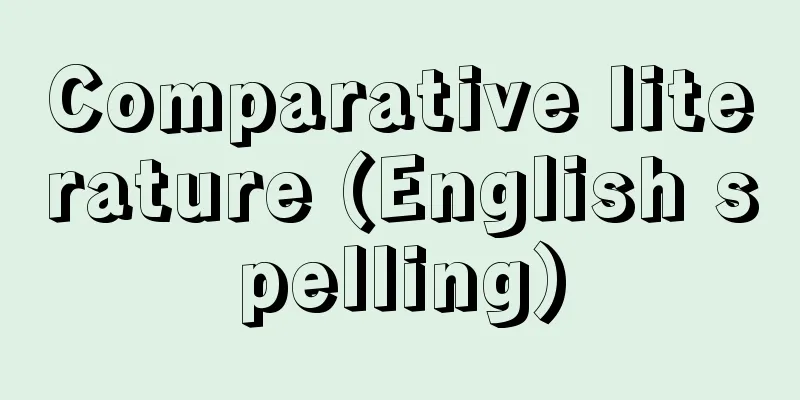Comparative literature (English spelling)

|
A field of literary studies that deals macroscopically with international literary phenomena that span two or more countries. As empirical research on literature becomes more advanced, there are often cases where a limited perspective within the literature of one country is insufficient. In the study of Natsume Soseki, Tayama Katai, and Akutagawa Ryunosuke, at some point it becomes necessary to know what foreign literature they absorbed, and in the study of The Tale of Genji, issues arise regarding its relationship to classical Chinese literature and how it was read and absorbed overseas through English translations by Waley, Seidensticker, and others. Not to mention the internationality of Dante, Shakespeare, Goethe, or the Bible, Aesop's Fables, Arabian Nights, and Grimm's Fairy Tales, any research that excludes Germany from Mori Ogai, Russia from Futabatei Shimei, England from Soseki, France from Nagai Kafu, and Japan from Lafcadio Hearn cannot avoid criticism of being biased. There are also writers and poets who wrote in two languages, such as Vicente, Rilke, Nabokov, Beckett, and Noguchi Yonejiro. Comparative literature scholars, who are familiar with the languages, literature, and cultures of several countries, handle such fields that are beyond the reach of Japanese literature scholars, filling in important gaps in the work of Japanese literature scholars and opening up new perspectives. [Kobayashi Roichi] Research SubjectsThe main task of comparative literature is to investigate factual relationships such as the international spread of literature (source and destiny), the international influence of authors and works (emission and reception), and the coexistence of heterogeneous literary factors (originality and coincidence), but it also sometimes deals with "contrastive research" between any two people who have similarities, such as Greek tragedy and Noh, Shakespeare and Chikamatsu Monzaemon, or Montaigne and Yoshida Kenko, and "comparative cultural studies," which deal with the transmission and exchange of not only literature but also art and culture in general. Contact with foreign literature is often through translation, except for a small number of readers who are fluent in foreign languages, and translators such as Mori Ogai, Ueda Bin, Nagai Kafu, and Horiguchi Daigaku, so the study of translation and translators, also known as "media studies," is one of the most important fields of comparative literature. For example, there are many interesting subjects, such as early translations, retranslations, and Chinese translations of "The Tales of Isoppo" (Aesop's Fables), "Yamato Bakufu" (Hamlet), and "The Adventures of the Dumb Old Man" (Don Quixote), which are stained with the marks of painstaking work, as well as adaptations of literature from "The Maid Child" and "The Tales of Ugetsu" through Kuroiwa Ruiko and Ozaki Koyo, and on to Shimazaki Toson, Akutagawa Ryunosuke, Nakajima Atsushi, Dazai Osamu, and Mishima Yukio. In addition, the field of research is extremely wide, including studies of imitation, plagiarism, corruption, and parody, the reading and overseas experiences of writers, the image of foreign countries (misunderstandings) that writers have seen that differ from the facts, international literary trends (classicism, romanticism, symbolism, surrealism, structuralism, etc.), international literary genres (sonnets, epistolary novels, historical novels, Japanese Chinese poetry, haiku, etc.), and surveys of the state of foreign literary research overseas. The term "comparative literature" is often misunderstood, but it does not necessarily mean a comparison of two things. It originally meant a unified literary study that broadens the scope of view to include countries outside of Japan and clarifies the reality of the relationships of influence. However, pluralistic and comprehensive wide-area research is also a field of comparative literature, and the overall understanding of the international spread of literary trends is specifically called "general literature." [Kobayashi Roichi] Origins and Present StatusComparative literature is the product of the demand for mutual exchange that arose as literary studies in European countries became clearly divided into individual countries and languages after the modern era. Following the footsteps of Brandes in Denmark and Saintsbury in England, comparative literature developed especially in France from the end of the 19th century. Since Fernand Baldensperger (1871-1958) and Hazard launched the Journal of Comparative Literature and the Series of Comparative Literature in Paris in 1921, comparative literature research in France has become a major academic field, focusing on detailed historical investigations of modern authors such as Rousseau, Goethe, and Balzac. Today, comparative literature research centers of various sizes are established in almost all major countries in the world, including France, the United States, Russia, Germany, Italy, and the Netherlands, and active research activities are being carried out. In Japan, comparative literature began in the 1880s with Tsubouchi Shoyo's "Comparative Literature" and "Brother Literature," and after World War II, it developed rapidly around several universities, including the University of Tokyo and Waseda University, and the Japan Comparative Literature Association (established in 1948). In particular, the contributions to comparative literature by Kinji Shimada, who founded the specialized course in comparative literature and culture at the University of Tokyo, have been significant. At present, comparative literature is at a turning point, and it is expected that in the future, in conjunction with existing microscopic and empirical research, literary phenomena around the world will be examined more broadly and freely, and the mystery of the birth of masterpieces, the cultural characteristics of each country and civilization, and ultimately the ultimate significance of literature and art for all of humanity will be clarified. At the same time, it has come to be taken for granted that many of the results of comparative literature research will be directly distributed and incorporated into the literature of each country, so that comparative literature, along with its own development, is also beginning to take on the appearance of a field of national literature. [Kobayashi Roichi] "Comparative Literature" by Guillard, translated by Fukuda Rikutaro (1953, Hakusuisha)" ▽ "Comparative Literature: Methods and Issues" edited by Waseda University Comparative Literature Research Center (1970, Waseda University Press)" ▽ "Lectures on Comparative Literature" edited by Nakajima Kenzo et al., 4 volumes (1971-74, Shimizu Kobundo)" ▽ "Prospects for Contemporary Comparative Literature" edited by Kamei Shunsuke (1972, Kenkyusha Publishing)" ▽ "Comparative Literature" edited by Yoshida Seiichi et al. (1972, Chobunsha)" ▽ "Comparative Literature" by Van Tieghem, translated by Tomita Hitoshi (1973, Shimizu Kobundo)" ▽ "Lectures on Comparative Literature" edited by Haga Toru et al., 8 volumes (1973-76, University of Tokyo Press)" ▽ "Foreign Literature in Japan" by Shimada Kinji, 2 volumes (1975, 76, Asahi Shimbun)" ▽ "Comparative Literature and Literary Theory" by Weisstein, translated by Matsumura Masaie (1977, Minerva Shobo)" ▽ "Dictionary of Comparative Literature" edited by Matsuda Jo (1978, Tokyodo Publishing)" ▽ "20th Century Literature Encyclopedia 16: Comparative Literature Research Literature Encyclopedia - Modern Japanese Literature and Western Literature 1945-1980" edited by Tomita Hitoshi (1984, Nichigai Associates)" ▽ "A Perspective on Different Cultures - For a New Comparative Literature" edited by Sasaki Hideaki (1996, Nagoya University Press)" ▽ "Introduction to Comparative Literature Research" by Watanabe Hiroshi (1997, Sekaishisosha)" ▽ "Perspectives on Comparative Literature: The Linguistic Universe Between Different Literatures" by Ando Gunichi (1999, Azusa Shoin)" ▽ "The Horizon of Comparative Literature: Contact between East and West" by Akiyama Masayuki (2000, Tokishiosha)" ▽ "Comparative Literature, by Y. Cheverel, translated by Rikutaro Fukuda (2001, Hakusuisha)" "A Comparative Literary Study of Kakekotoba, by Roi Kobayashi (2001, Waseda University Press)" [References] | | | | |Source: Shogakukan Encyclopedia Nipponica About Encyclopedia Nipponica Information | Legend |
|
文学研究の一分野で、2か国以上にわたる国際的な文学現象を巨視的に扱う。文学の実証的研究が高度に発達してくると、限定された一国文学内の視野では不十分な場合が頻出する。夏目漱石(そうせき)や田山花袋(かたい)や芥川龍之介(あくたがわりゅうのすけ)の研究では、ある段階で当然彼らが外国の諸文学から摂取したものを知る必要に迫られるし、『源氏物語』の研究では、その中国古典文学との関連や、ウェーリー、サイデンステッカーらの英訳を通して海外でどのように読まれ、摂取されたかが問題となる。ダンテ、シェークスピア、ゲーテ、あるいは『聖書』『イソップ物語』『アラビアン・ナイト』『グリム童話』などの国際性はいわずもがな、森鴎外(おうがい)からドイツを、二葉亭四迷(ふたばていしめい)からロシアを、漱石からイギリスを、永井荷風(かふう)からフランスを、ラフカディオ・ハーンから日本を取り去っての研究は偏頗(へんぱ)のそしりを免れえない。ビセンテ、リルケ、ナボコフ、ベケット、野口米次郎(よねじろう)らのように、2か国語で書いた作家・詩人もいる。こうした、国文学者の手に負えない分野を扱うのが、数か国の言語・文学・文化に通じた比較文学者であり、国文学研究の後を受けてその重要な欠落部分を補うとともに、新たな展望を拓(ひら)く。 [小林路易] 研究対象文学の国際的伝播(でんぱ)(源泉と運命)、作家・作品の国際的影響(放出と受容)、異質の文学要因の併存(独創と暗合)など、事実関係の追究が比較文学の主たる任務であるが、ときには、ギリシア悲劇と能、シェークスピアと近松門左衛門、モンテーニュと吉田兼好(けんこう)のような類似性をもつ任意の二者間の「対比研究」や、文学のみならず芸術・文化一般の伝承・授受を扱う「比較文化学」をも手がける。海外文学との接触は、外国語に堪能(たんのう)な一部の読者や、森鴎外・上田敏・永井荷風・堀口大学などの翻訳者を除いて翻訳によることが多いから、翻訳および翻訳者の研究もまた「媒体研究」とよばれる比較文学のもっとも重要な一分野である。たとえば、『伊曽保(いそほ)物語』(イソップ物語)、『葉武烈土』(ハムレット)、『鈍機翁冒険譚(たん)』(ドン・キホーテ)など苦心のあとのにじんだ初期の翻訳、重訳、漢文訳や、『御伽婢子(おとぎぼうこ)』『雨月(うげつ)物語』から黒岩涙香(るいこう)、尾崎紅葉(こうよう)を経て、島崎藤村(とうそん)、芥川龍之介、中島敦(あつし)、太宰治(だざいおさむ)、三島由紀夫らに至る翻案文学など、興味深い対象が多い。そのほか、模倣・剽窃(ひょうせつ)・転訛(てんか)・もじりの研究、作家の読書や海外体験の研究、作家の目に映った、事実とは異なる外国のイメージ(迷景)の研究、国際的文学潮流(古典主義、ロマン主義、象徴主義、超現実主義、構造主義など)、国際的文芸ジャンル(ソネット、書簡体小説、歴史小説、日本漢詩、俳句など)の研究、海外における外国文学研究の実態調査など、研究領域はすこぶる広い。「比較文学」の名称は誤解されやすいが、かならずしも二者の比較ということではなく、本来は視野を国外にまで大きく広げて影響関係の実体を明らかにする一元的文学研究の意である。ただし、多元的、網羅的な広域研究もまた比較文学研究の一分野で、文芸思潮の国際的な広がりの全体的な把握は、とくに「一般文学」の名でよばれている。 [小林路易] 起源と現況比較文学は、ヨーロッパ諸国の文学研究が近代以後、各国別・各言語別に画然と縦割りで行われるようになるにしたがっておこった相互交流の要請の産物であり、デンマークのブランデス、イギリスのセンツベリらの先蹤(せんしょう)を経て、19世紀末からことにフランスにおいて発達した。1921年、バルダンスペルジェFernand Baldensperger(1871―1958)とアザールによって『比較文学雑誌』と『比較文学叢書(そうしょ)』がパリで創刊されて以来、ルソー、ゲーテ、バルザックなど近代作家に関する細かい歴史的事実の精査を中心に、フランスでの比較文学研究は一大学派をなした。今日ではフランスのほか、アメリカ、ロシア、ドイツ、イタリア、オランダなど世界の主要国のほとんどすべてに大なり小なり比較文学の研究センターが置かれ、活発な研究活動が行われている。 日本では明治20年代、坪内逍遙(しょうよう)の「比照文学」「兄弟文学」に始まり、第二次世界大戦後、東京大学・早稲田(わせだ)大学などいくつかの大学と日本比較文学会(1948設立)を中心に急速に発達した。なかんずく、東大に比較文学比較文化専門課程を創設した島田謹二の斯学(しがく)への貢献は大きい。 現在、比較文学は転換期にあり、今後、在来の微視的、実証的な研究と相まって、さらに広く、さらに自由に世界の文学現象が検討され、傑作誕生の神秘や、各国・各文明圏の文化的特性、ひいては全人類にとっての文学・芸術の究極的な意義が闡明(せんめい)されるようになることが期待されている。それと同時に、比較文学の研究成果の多くは、直接各国文学それぞれのなかへ分散して取り込まれるのが当然とみられるようになってきたから、比較文学はそれ独自の発達とともに、各国国文学の一分野の相貌(そうぼう)も呈しはじめている。 [小林路易] 『ギュイヤール著、福田陸太郎訳『比較文学』(1953・白水社)』▽『早稲田大学比較文学研究室編『比較文学――方法と課題』(1970・早稲田大学出版部)』▽『中島健蔵他編『比較文学講座』全4巻(1971~74・清水弘文堂)』▽『亀井俊介編『現代比較文学の展望』(1972・研究社出版)』▽『吉田精一他編『比較文学』(1972・潮文社)』▽『ヴァン・ティーゲム著、富田仁訳『比較文学』(1973・清水弘文堂)』▽『芳賀徹他編『講座比較文学』全8巻(1973~76・東京大学出版会)』▽『島田謹二著『日本における外国文学』全2巻(1975、76・朝日新聞社)』▽『ヴァイスシュタイン著、松村昌家訳『比較文学と文学理論』(1977・ミネルヴァ書房)』▽『松田穣編『比較文学辞典』(1978・東京堂出版)』▽『富田仁編『20世紀文献要覧大系16 比較文学研究文献要覧――日本近代文学と西洋文学1945~1980』(1984・日外アソシェーツ)』▽『佐々木英昭編『異文化への視線――新しい比較文学のために』(1996・名古屋大学出版会)』▽『渡辺洋著『比較文学研究入門』(1997・世界思想社)』▽『安徳軍一著『比較文学の視座 異文学間の言語宇宙』(1999・梓書院)』▽『秋山正幸著『比較文学の地平 東西の接触』(2000・時潮社)』▽『Y・シュヴレル著、福田陸太郎訳『比較文学』(2001・白水社)』▽『小林路易著『掛詞の比較文学的考察』(2001・早稲田大学出版部)』 [参照項目] | | | | |出典 小学館 日本大百科全書(ニッポニカ)日本大百科全書(ニッポニカ)について 情報 | 凡例 |
>>: Comparison length measuring device
Recommend
Kose no Notari - Kose no Notari
Year of death: 14 December 7th of the Kōnin period...
Isewan Typhoon
This refers to Typhoon No. 15 of 1959 (Showa 34)....
Purified water - Jousui
〘noun〙① pure water. Clear water. Shimizu. ※Ryōiki ...
Cosmopolites sordidus
...The two broad segments (culm part) at the tip ...
Kamigata dialect - Kamigata
〘 noun 〙 = Kamigata kotoba (Kamigata dialect) ※Fud...
School clique - Gakubatsu (English spelling)
A clique is a group that is structured around a s...
Mud dauber (mud wasp)
A general term for insects in the Eumenidae family...
European plum
… [Isao Shimura]. … *Some of the terminology expl...
Precious stone
This refers to gemstones such as diamonds, rubies,...
Wakefield
A city in the southeast of West Yorkshire, north-c...
smegma
…Generally, in adults, the foreskin is pulled bac...
Kolbenheyer - Erwin Guido Kolbenheyer
1878‐1962 German author. Born in Budapest, he was ...
"Kamakura Hiji Aotosen" - Kamakura Hiji Aotosen
...In August 1789 (Kansei 1), the Osaka Kotayuza ...
Cimbri - Cimbri (English spelling)
An ancient Germanic tribe. In the 2nd century BC, ...
Carlos II
1661‐1700 King of Spain. Reigned 1665-1700. He was...









